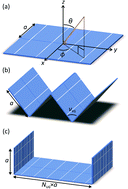当前位置:
X-MOL 学术
›
Sustain. Energy Fuels
›
论文详情
Our official English website, www.x-mol.net, welcomes your feedback! (Note: you will need to create a separate account there.)
Design and performance analyses of solar arrays towards a metric of energy value†
Sustainable Energy & Fuels ( IF 5.6 ) Pub Date : 2018-07-17 00:00:00 , DOI: 10.1039/c8se00333e Adrian B. Boivin 1, 2, 3, 4 , Timothy M. Westgate 1, 2, 3, 4 , Jonathan F. Holzman 1, 2, 3, 4
Sustainable Energy & Fuels ( IF 5.6 ) Pub Date : 2018-07-17 00:00:00 , DOI: 10.1039/c8se00333e Adrian B. Boivin 1, 2, 3, 4 , Timothy M. Westgate 1, 2, 3, 4 , Jonathan F. Holzman 1, 2, 3, 4
Affiliation

|
In this work, the contemporary approach of analyzing and optimizing solar technology according to conversion efficiency is expanded upon to recognize an emerging paradigm for supply and demand of solar power. The analyses and optimizations are carried out with respect to energy value density, in units of dollars per metre-squared, rather than simple energy density, in units of watt hours per metre-squared, given an emerging trend in electricity prices that has become known as the duck curve. Such an approach is motivated by economic factors, in areas such as California, where dynamic solar power generation leads to high supply during mid-day hours, when the demand is low, and low supply during early- and late-day hours, when the demand is high. With this in mind, the metric of energy value density is analyzed for three silicon-based solar arrays: the flat-panel array, as an established benchmark, the V-groove array, as an array with enhanced conversion efficiency, and the U-groove array, as a newly-proposed array with strong performance for energy value density. Experimental characterizations and theoretical analyses are shown for the arrays' energy value density over July 2012 to June 2018. It is shown that the U-groove array yields the greatest performance in terms of energy value density – and the extent of its outperformance is growing. Over the last year of the study, the U-groove array generated 0.36% more value than the V-groove array and 8.76% more value than the flat-panel array. The prospects for such findings to the solar industry are discussed.
中文翻译:

朝着能量值度量标准的太阳能电池阵列的设计和性能分析†
在这项工作中,根据转换效率分析和优化太阳能技术的当代方法得到了扩展,以认识到新兴的太阳能供需范例。考虑到电价的一种新兴趋势,已经针对能量值密度(以美元/平方米为单位)进行了分析和优化,而不是简单的能量密度(以瓦特/平方米为单位)进行了分析和优化。像鸭子的曲线。这种方法是受经济因素驱动的,例如在加利福尼亚州等地区,动态太阳能发电导致中午时段(需求低迷)的高供应量,以及早晚时段(白天和低迷时段)的低电量供应。需求很高。考虑到这一点,对三种硅基太阳能电池阵列的能量值密度度量进行了分析:平板阵列作为已确立的基准,V槽阵列是提高转换效率的阵列,而U槽阵列是新提出的,具有高能效值密度性能的阵列。对阵列在2012年7月至2018年6月的能量值密度进行了实验表征和理论分析。结果表明,就能量值密度而言,U形槽阵列表现出最大的性能,并且其性能表现的程度在不断提高。在研究的最后一年,U形槽阵列的价值比V形槽阵列高0.36%,比平板阵列高8.76%。讨论了这种发现对太阳能行业的前景。以及U形槽阵列,这是一个新提出的阵列,具有很强的能量值密度性能。对阵列在2012年7月至2018年6月的能量值密度进行了实验表征和理论分析。结果表明,就能量值密度而言,U形槽阵列表现出最大的性能,并且其性能表现的程度在不断提高。在研究的最后一年,U形槽阵列的价值比V形槽阵列高0.36%,比平板阵列高8.76%。讨论了这种发现对太阳能行业的前景。以及U形槽阵列,这是一个新提出的阵列,具有很强的能量值密度性能。对阵列在2012年7月至2018年6月的能量值密度进行了实验表征和理论分析。结果表明,就能量值密度而言,U形槽阵列表现出最大的性能,并且其性能表现的程度在不断提高。在研究的最后一年,U形槽阵列的价值比V形槽阵列高0.36%,比平板阵列高8.76%。讨论了这种发现对太阳能行业的前景。结果表明,就能量值密度而言,U形槽阵列的性能最高-且其性能的范围在不断扩大。在研究的最后一年,U形槽阵列的价值比V形槽阵列高0.36%,比平板阵列高8.76%。讨论了这种发现对太阳能行业的前景。结果表明,就能量值密度而言,U形槽阵列的性能最高-且其性能的范围在不断扩大。在研究的最后一年,U形槽阵列的价值比V形槽阵列高0.36%,比平板阵列高8.76%。讨论了这种发现对太阳能行业的前景。
更新日期:2018-07-17
中文翻译:

朝着能量值度量标准的太阳能电池阵列的设计和性能分析†
在这项工作中,根据转换效率分析和优化太阳能技术的当代方法得到了扩展,以认识到新兴的太阳能供需范例。考虑到电价的一种新兴趋势,已经针对能量值密度(以美元/平方米为单位)进行了分析和优化,而不是简单的能量密度(以瓦特/平方米为单位)进行了分析和优化。像鸭子的曲线。这种方法是受经济因素驱动的,例如在加利福尼亚州等地区,动态太阳能发电导致中午时段(需求低迷)的高供应量,以及早晚时段(白天和低迷时段)的低电量供应。需求很高。考虑到这一点,对三种硅基太阳能电池阵列的能量值密度度量进行了分析:平板阵列作为已确立的基准,V槽阵列是提高转换效率的阵列,而U槽阵列是新提出的,具有高能效值密度性能的阵列。对阵列在2012年7月至2018年6月的能量值密度进行了实验表征和理论分析。结果表明,就能量值密度而言,U形槽阵列表现出最大的性能,并且其性能表现的程度在不断提高。在研究的最后一年,U形槽阵列的价值比V形槽阵列高0.36%,比平板阵列高8.76%。讨论了这种发现对太阳能行业的前景。以及U形槽阵列,这是一个新提出的阵列,具有很强的能量值密度性能。对阵列在2012年7月至2018年6月的能量值密度进行了实验表征和理论分析。结果表明,就能量值密度而言,U形槽阵列表现出最大的性能,并且其性能表现的程度在不断提高。在研究的最后一年,U形槽阵列的价值比V形槽阵列高0.36%,比平板阵列高8.76%。讨论了这种发现对太阳能行业的前景。以及U形槽阵列,这是一个新提出的阵列,具有很强的能量值密度性能。对阵列在2012年7月至2018年6月的能量值密度进行了实验表征和理论分析。结果表明,就能量值密度而言,U形槽阵列表现出最大的性能,并且其性能表现的程度在不断提高。在研究的最后一年,U形槽阵列的价值比V形槽阵列高0.36%,比平板阵列高8.76%。讨论了这种发现对太阳能行业的前景。结果表明,就能量值密度而言,U形槽阵列的性能最高-且其性能的范围在不断扩大。在研究的最后一年,U形槽阵列的价值比V形槽阵列高0.36%,比平板阵列高8.76%。讨论了这种发现对太阳能行业的前景。结果表明,就能量值密度而言,U形槽阵列的性能最高-且其性能的范围在不断扩大。在研究的最后一年,U形槽阵列的价值比V形槽阵列高0.36%,比平板阵列高8.76%。讨论了这种发现对太阳能行业的前景。


























 京公网安备 11010802027423号
京公网安备 11010802027423号